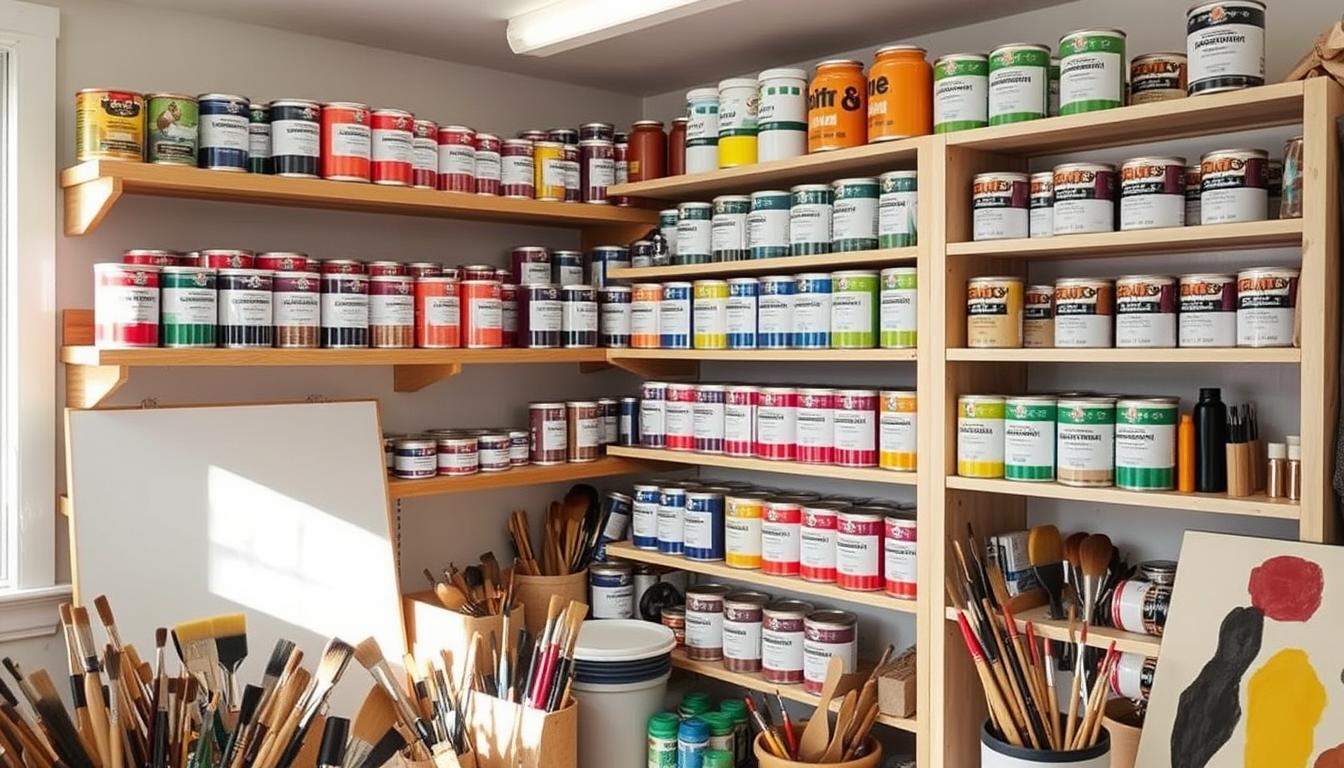Proper paint storage is vital for maintaining paint quality and shelf life. Improper storage can cause paint to dry out, spoil, and go to waste. Effective preservation requires careful attention to storage conditions and sealing containers. By adopting the right methods, you can extend paint usability, reducing the need for frequent replacements and saving money. Paint storage and preservation are critical for any painting endeavor.
Understanding the significance of proper paint storage and preservation is key to making informed decisions. This article will offer tips and techniques for storing paint effectively. We’ll discuss the importance of proper storage conditions, container sealing, and organization. By applying these strategies, you can prolong your paint’s life and ensure it’s ready for your next project. Proper storage and preservation are essential for achieving professional results and minimizing waste.
Key Takeaways
- Proper paint storage is essential for maintaining paint quality and shelf life
- Effective paint preservation requires attention to storage conditions and container sealing
- Paint storage and preservation can help reduce waste and save money
- Proper storage conditions are crucial for extending the life of paint
- Container sealing and organization are important aspects of paint storage and preservation
- Following the right techniques can help you achieve professional-looking results
Understanding the Basics of Paint Storage
Proper paint storage is key to keeping leftover paint quality and shelf life intact. It’s vital to consider the paint type when storing. Each paint type has its own storage needs, and knowing these can help store paint effectively.
Latex paint needs a cool, dry spot with little sunlight. Oil-based paint requires a well-ventilated area with steady temperatures. Epoxy paint must be stored at a specific temperature to stay potent. By meeting these storage conditions, you can extend your paint’s usability.
Different Types of Paint and Their Storage Needs
- Latex paint: store in a cool, dry place with minimal sunlight exposure
- Oil-based paint: store in a well-ventilated area with a consistent temperature
- Epoxy paint: store at a specific temperature to maintain potency
Why Proper Storage Matters
Proper storage conditions are crucial for paint quality and shelf life. Incorrect storage can cause paint to dry out, thicken, or become contaminated. Storing paint correctly prevents these issues, ensuring it’s ready for future projects.
Common Paint Storage Mistakes to Avoid
Many people overlook checking storage conditions, leading to paint deterioration. Not labeling paint containers is another mistake, making it hard to identify the paint type and storage needs. By avoiding these errors and following proper storage guidelines, you can extend your paint’s life and keep it in good condition.
Ideal Temperature and Environmental Conditions
Storing paint correctly is key to its longevity. The perfect temperature for paint storage is between 60°F and 80°F (15°C and 27°C). This range, with minimal temperature changes, prevents paint spoilage or degradation.
Humidity levels also play a significant role in storage conditions. Aim for a relative humidity of 50-60%. High humidity can make paint too thin, while low humidity can thicken it. Good ventilation is crucial to avoid fume and moisture buildup.
Lighting conditions also affect paint shelf life. Direct sunlight and intense lighting can cause paint to fade or change color. Store paint in a shaded area or use containers that block UV rays. By controlling temperature, humidity, and light, you can extend paint shelf life and keep it fresh longer.
When assessing storage conditions, consider these factors:
- Avoid extreme temperatures
- Keep humidity levels consistent
- Ensure proper ventilation
- Reduce direct sunlight exposure
Selecting the Perfect Storage Location
The location for storing paint is as crucial as the container itself. Proper container sealing and organization significantly impact paint quality and shelf life. It’s vital to weigh the advantages and disadvantages of basements, garages, and climate-controlled spaces to find the ideal spot for your paint.
Basements can be an excellent choice due to their cooler and more stable conditions. Yet, it’s crucial to confirm the basement is dry and devoid of moisture to avoid paint damage. Garages, while convenient, may face temperature changes and direct sunlight exposure.
Basement Storage Considerations
- Check for moisture and humidity levels
- Ensure the area is well-ventilated
- Keep paint away from direct sunlight
Garage Storage Solutions
- Use shelves or cabinets to keep paint off the floor
- Consider using a storage bin or container with a tight-fitting lid
- Label each container with its contents and the date it was stored
By meticulously choosing a storage location and applying effective container sealing and organization methods, you can prolong your paint’s life. This ensures it remains in optimal condition for future projects.
Professional Paint Storage Techniques and Methods
Proper storage conditions are key for paint preservation. Use airtight containers to block air and moisture. This keeps the paint quality high and prevents spoilage.
Keeping your storage area organized is vital for paint preservation. Label and manage your paint inventory. This makes it easy to spot paints that are close to expiring. You can then use or dispose of them as needed.
- Use airtight containers to prevent air exposure and moisture
- Label and manage inventory to track paint types and storage conditions
- Maintain a clean and organized storage area to prevent contamination
Adopting these professional paint storage techniques ensures optimal storage conditions. This extends your paint’s shelf life. It saves money, reduces waste, and minimizes environmental impact from paint disposal.
Effective paint preservation demands attention to detail and the right storage conditions. By implementing these methods, you’ll enjoy long-lasting, high-quality paint for all your projects.
Container Maintenance and Sealing Tips
Proper paint storage is essential for maintaining paint quality and longevity. Container maintenance and sealing are key. A well-sealed container prevents air, moisture, and contaminants from reaching the paint.
Proper Lid Sealing Techniques
Ensuring a tight seal is crucial. Clean the lid and container before sealing. Apply a thin layer of paint or sealant to the lid. Then, tighten the lid securely.
Preventing Air Exposure
Air exposure can dry out, thicken, or spoil paint. Use airtight containers and store them in a cool, dry place. Regularly inspect containers for damage or wear.
Transfer Container Options
Choosing the right container for paint transfer is vital. Opt for containers designed for paint storage. Look for those with airtight lids and spill-proof designs.
Some top paint storage container options include:
- Plastic containers with tight-fitting lids
- Glass containers with airtight lids
- Metal containers with rust-resistant coatings
By adhering to these container maintenance and sealing tips, your paint will stay fresh and usable longer. Always inspect containers for damage and use proper sealing techniques to prevent air and moisture exposure.
| Container Type | Advantages | Disadvantages |
|---|---|---|
| Plastic | Affordable, lightweight, easy to clean | May not be airtight, prone to scratches |
| Glass | Airtight, non-porous, easy to clean | Heavy, expensive, prone to breakage |
| Metal | Durable, rust-resistant, airtight | Heavy, expensive, may rust over time |
Maximizing Paint Shelf Life
Keeping your paint in optimal conditions is crucial for its quality and paint shelf life. Store it in a cool, dry spot, away from sunlight and moisture. This ensures your paint stays usable for longer.
It’s important to regularly check your paint for spoilage signs. Look for mold, mildew, or any separation of paint components. This step is essential for paint preservation.
Here are some tips to extend your paint shelf life:
- Use airtight containers to block air and moisture.
- Avoid placing paint near heat sources or direct sunlight.
- Label containers with the opening date and paint type to use the oldest first.
By adhering to these guidelines, you can prolong your paint’s paint shelf life. Remember, proper storage and handling are vital for paint preservation.
Organization Systems for Leftover Paint
Proper organization is key when dealing with leftover paint. A well-organized system helps you keep track of your paint. This makes it easier to find what you need, saving time and money by reducing waste.
Effective organization involves labeling, inventory management, and digital tracking. These components help tailor a system to your needs. They ensure you maximize your leftover paint’s value.
Labeling Best Practices
- Use a clear and consistent labeling system to identify the type and amount of paint in each container.
- Include the date the paint was purchased or opened to help you keep track of how long it has been stored.
- Consider using color-coded labels to categorize paint by type or room.
Inventory Management Tips
Regularly review your paint inventory to ensure you are not storing too much leftover paint. Consider donating or disposing of paint that is no longer needed or has exceeded its shelf life.
Digital Tracking Methods
Consider using a digital tool, such as a spreadsheet or app, to track your paint inventory and storage. This can help you quickly and easily access information about the paint you have. It makes managing your organization system easier.
Identifying and Disposing of Expired Paint
Proper paint storage and paint preservation are key to extending paint life. Yet, paint can still expire, even with ideal storage. It’s vital to recognize signs of deterioration for safe, eco-friendly disposal.
Common signs of paint deterioration include color, texture, and consistency changes. If you spot these signs, your paint has likely expired. To get rid of expired paint, consider these options:
- Check with your local waste management facility to see if they accept expired paint
- Participate in community paint storage and disposal events
- Donate unused paint to local charities or organizations
When disposing of expired paint, choose eco-friendly methods to lessen environmental impact. This includes recycling and proper disposal. Proper disposal of expired paint helps reduce waste and supports a sustainable future for paint preservation.
Remember, proper paint storage and disposal are crucial for a safe, healthy environment. By adhering to these tips and guidelines, you ensure paint is stored and disposed of responsibly. This reduces environmental harm and supports a sustainable future for paint preservation.
Conclusion: Ensuring Long-Term Paint Preservation Success
In this comprehensive guide, we’ve explored essential strategies for proper paint storage and long-term preservation. Understanding the specific storage needs of different paint types is crucial. Implementing effective organization and disposal methods is also key. The quality and shelf life of your paint depend on diligent attention to detail.
By following the best practices outlined, you can maintain ideal temperature and humidity conditions. Use appropriate storage containers and regularly inspect your paint supply. This ensures your paints remain in pristine condition for years. Proper paint storage techniques extend paint lifespan, save money, and reduce waste. This contributes to a more sustainable home improvement journey.
Whether you’re a professional painter, a DIY enthusiast, or simply maintaining your paint collection, this article offers valuable insights. Embrace these strategies to take control of your paint storage and preservation efforts. You’ll be well on your way to achieving long-lasting, high-quality paint results in all your future projects.


